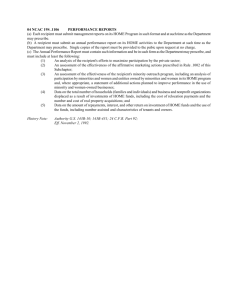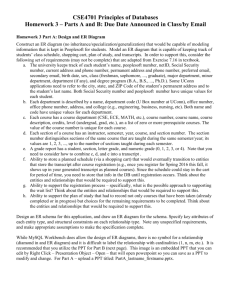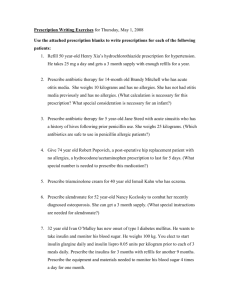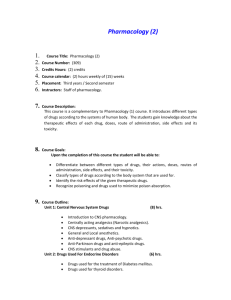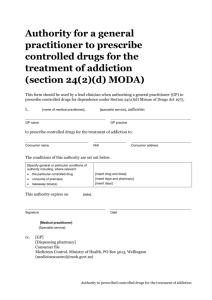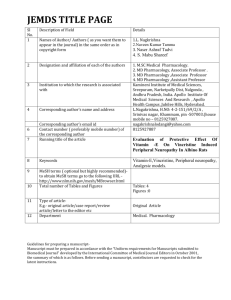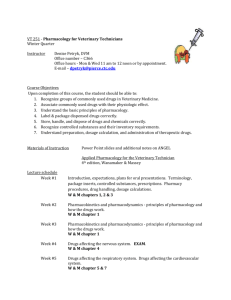Program Ph_dent_Eng - web базирано обучение по
advertisement
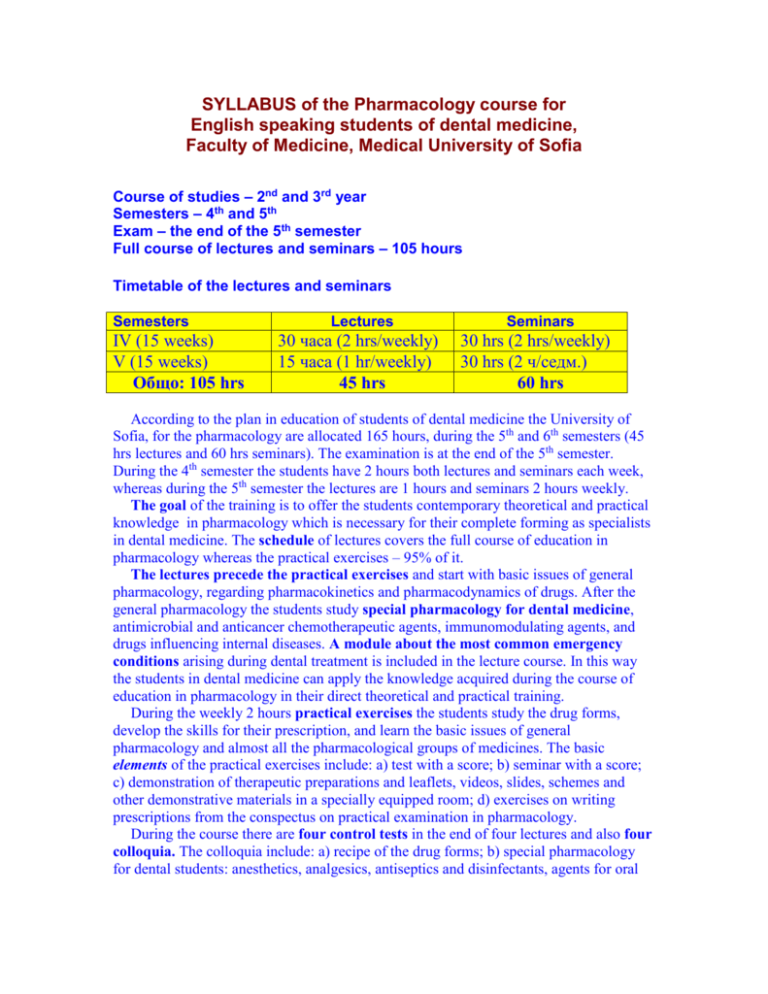
SYLLABUS of the Pharmacology course for English speaking students of dental medicine, Faculty of Medicine, Medical University of Sofia Course of studies – 2nd and 3rd year Semesters – 4th and 5th Exam – the end of the 5th semester Full course of lectures and seminars – 105 hours Timetable of the lectures and seminars Semesters IV (15 weeks) V (15 weeks) Общо: 105 hrs Lectures 30 часа (2 hrs/weekly) 15 часа (1 hr/weekly) 45 hrs Seminars 30 hrs (2 hrs/weekly) 30 hrs (2 ч/седм.) 60 hrs According to the plan in education of students of dental medicine the University of Sofia, for the pharmacology are allocated 165 hours, during the 5th and 6th semesters (45 hrs lectures and 60 hrs seminars). The examination is at the end of the 5th semester. During the 4th semester the students have 2 hours both lectures and seminars each week, whereas during the 5th semester the lectures are 1 hours and seminars 2 hours weekly. The goal of the training is to offer the students contemporary theoretical and practical knowledge in pharmacology which is necessary for their complete forming as specialists in dental medicine. The schedule of lectures covers the full course of education in pharmacology whereas the practical exercises – 95% of it. The lectures precede the practical exercises and start with basic issues of general pharmacology, regarding pharmacokinetics and pharmacodynamics of drugs. After the general pharmacology the students study special pharmacology for dental medicine, antimicrobial and anticancer chemotherapeutic agents, immunomodulating agents, and drugs influencing internal diseases. A module about the most common emergency conditions arising during dental treatment is included in the lecture course. In this way the students in dental medicine can apply the knowledge acquired during the course of education in pharmacology in their direct theoretical and practical training. During the weekly 2 hours practical exercises the students study the drug forms, develop the skills for their prescription, and learn the basic issues of general pharmacology and almost all the pharmacological groups of medicines. The basic elements of the practical exercises include: a) test with a score; b) seminar with a score; c) demonstration of therapeutic preparations and leaflets, videos, slides, schemes and other demonstrative materials in a specially equipped room; d) exercises on writing prescriptions from the conspectus on practical examination in pharmacology. During the course there are four control tests in the end of four lectures and also four colloquia. The colloquia include: a) recipe of the drug forms; b) special pharmacology for dental students: anesthetics, analgesics, antiseptics and disinfectants, agents for oral hygiene and therapy; c) anti-infective agents and immunomodulators; d) cardiovascular drugs, and drugs influencing the haemopoiesis and blood coagulation. The pharmacology exam consists of a written test, a practical exam with prescription of recipes and an oral theoretical exam. The final score of the exam on pharmacology is formed as a whole, by evaluation of the activity of the students during the training course (current scores, control tests, colloquia) and the exam result of the session (exam test, practical exam, theoretical exam). The selection of the test, of the examination tickets and of the examination commission is on a lottery principle. The examination commission consists of a habilitated and a non-habilitated lecturer. The examination commissions are also formed on a lottery principle immediately before the start of the exam. This present pharmacology course program is in accordance with the programs of leading universities in a number of European countries. There are a specialized textbook and tests in Bulgarian language for students in dental medicine (indicated in the present program). They are published under the edition of, and with the active participation of habilitated lecturers from the Department of Pharmacology and Toxicology at the Faculty of Medicine– Sofia and the Department of Pharmacology at the Faculty of Medicine – Plovdiv, in collaboration with the Faculties of Dental Medicine in Sofia and Plovdiv. Furthermore, students are recommended to use additional pharmacology literature of Bulgarian and foreign authors, videos and computer module programs. Synopsis of the pharmacology lectures: A. GENERAL PRINCIPLES OF PHARMACOLOGY 1. Introduction to pharmacology (2 hrs): Object and tasks of pharmacology. Relationship with other sciences. Historical review. Division of medical pharmacology. Definition of drug. Drug cruds and preparations. Stages in development and regulations of new drugs. 2. General pharmacokinetics (2 hrs) 2.1. Absorption of drugs. Transport of drugs through biologic membranes after enteral and parenteral administration. 2.2. Drug distribution. Binding of drugs to plasma proteins. Barrier systems (blood-brain, placenta, blood-milk). Basic pharmacokinetic parameters: bioavailability, volume of distribution, first pass metabolism, binding capacity of albumin, plasma half-life of the drugs. 2.3. Biotransformation of drugs. Prodrugs. Sites of drug metabolism. Phase I and phase II reactions of drug metabolism. Inducers and inhibitors of the drug-metabolizing enzymes. 2.4. Excretion of drugs and their metabolites. Excretion of drugs via kidney, bile, intestine, lung, salivary glands, or milk in nursing mothers. 3. General pharmacodynamics (1 hr) 3.1. Drug action and drug effect. 3.2. Specific mechanisms of drug action (receptors, ion channels, enzymes, transport systems). Definition of receptor. Affinity and intrinsic activity of the drugs. Agonists and antagonists. Types of receptors. Second messengers (cyclic adenosine monophosphate, inositol-1,4,5-triphosphate, and diacylglycerol). 2 3.3. Non-specific mechanisms of drug action. 3.4. Types of drug effects. 3.5. Drug effects in the mouth. 4. Factors affecting the kinetics and action of the drugs (1 hr) 4.1. Drug properties affecting its kinetics and action. Physical characteristic, physicochemical characteristic, and chemical structure of the drugs. Drug forms. Dose (types of dose, therapeutic index). Loading and maintenance dose. 4.2. The role of environment on the kinetics and action of the drugs. 4.3. Factors of human body affecting drugs action. A role of age, body weight and sex in both kinetics and action of the drugs. Genetic factors and pathological processes on the kinetics and action of the drugs. 5. Peculiarities of drugs action due their multiple applications (1 hr) 5.1. Tachyphylaxis. 5.2. Tolerance. 5.3. Drug dependence. 5.4. Resistance. 5.5. Allergic reactions. 5.6. Cumulation. 6. Unwanted drug reactions. Drug toxicology (2 hrs) 6.1. Adverse effects related to the main pharmacological action of the drug. 6.2. Adverse effects related to the pharmacokinetics of drug. 6.3. Allergic reactions. Idiosyncratic reactions. 6.4. Drug dependence: characteristic and types. 6.5. Drug toxicity: nephrotoxicity, hepatotoxicity, hematotoxicity, ototoxicity, ophthalmotoxicity, and neurotoxicity. 6.6. Drug-induced fetal damage. 6.7. Mutagenesis and carcinogenesis. 6.8. Dug intoxication. Antidotes. 7. Drug interactions (1 hr) 7.1. Pharmaceutical drug interactions. 7.2. Pharmacokinetics drugs interactions. 7.3. Pharmacodynamic drugs interactions: additive effects, synergism, antagonism. 7.4. Interaction of the drugs with alcohol, nicotine, and psychosomimetics. Drugs affecting clinical laboratory tests. B. SPECIAL PHARMACOLOGY I. SPECIAL PHARMACOLOGY FOR DENTISTS 1. Anesthetics. Antihistamines (2 hrs) 1.1. Local anesthetics: Techniques of local anesthesia. Pharmacodynamics, pharmacokinetics, drug interactions, and adverse drug reactions of local anesthetics. Esters. Amides. 1.2. General anesthetics: Inhalation anesthetics. Injectable anesthetics. 3 1.3. Antihistamines: Н1-receptor blockers. Н2-receptor antagonists. Mast cell stabilizers (ketotifen, cromolyn, nedocromil). 2. Analgesics (2 hrs) 2.1. Opioid analgesics: Pharmacodynamics – endogenous opioids, type of opioid receptors, pharmacological effects of opioids. Clinical uses of opioid analgesics. Adverse drug reactions of opioids. Opioid overdose. Opioid antagonists. 2.2. Non-opioid analgesics (paracetamol, metamizole). Nonsteroidal anti-inflammatory drugs (NSAIDs) – salicylic acid derivatives, acetic acid derivatives, propionic acid derivatives, enolic acid derivatives (oxicams). Pharmacodynamics – non-selective and selective COX inhibitors. Adverse effects of non-opioid analgesics and NSAIDs. 3. Antiseptics and disinfectants. Agents used in pulp devitalization and anti-caries agents. Drugs for treatment of parodonthosis (2 hrs) 3.1. Antiseptics and disinfectants. 3.2. Agents used in pulp devitalization. 3.3. Fluorides. 3.4. Drugs for treatment of parodonthosis. II. ANTI-INFECTIVE DRUGS 1. Anti-infective drugs – part I: Antibiotics (2 hrs) 1.1. Penicillins. Carbapenems and monobactams. 1.2. Cephalosporins. 1.3. Inhibitors of bacterial protein synthesis: aminoglycosides, macrolides, tetracyclines, chloramphenicol, lincosamides. 1.4. Other antibiotics: polymixins, bacitracin,vancomycin, linezolid, tigecycline. 2. Anti-infective drugs – part II (1 hr) 2.1. Sulfonamides. 2.2. Quinolones. 2.3. Metronidazole. 3. Anti-infective drugs – part III (1 hr) 3.1. Antifungal drugs. 3.2. Antiviral agents. III. ANTICANCER DRUGS. IMMUNOPHARMACOLOGY. 1. Anticancer drugs (1 hr) 1.1. Alkylating agents (Chlorambucil, Busulfan, Cyclophosphamide, Carmustine). 1.2. Antimetabolites (Methotrexate, 5-Fluorouracil, Azathioprine, Cytarabine). 1.3. Microtubule inhibitors (Vincristine, Vinblastine, Paclitaxel, Docetaxel). 1.4. Anticancer antibiotics (Bleomycin, Dactinomycin, Doxorubicin) 1.5. Hormones used to treat cancer (Prednisone, Estrogens, Tamoxifen). 2. Immunopharmacology (1 hr) 2.1. Immunomodulators – immunostimulators and immunosuppressive drugs. 4 2.2. Immunomodulating and cytotoxic drugs used to treat diseases affecting oral mucosa. IV. NEUROTROPIC AND PSYCHOTROPIC DRUGS 1. Drugs affecting the autonomic nervous systems (4 hrs). 1.1. Cholinergic neurotransmission. 1.2. Direct and indirect-acting cholinomimetics. 1.3. М-cholinergic antagonists. 1.4. Neuromuscular blockers. 1.5. Adrenergic neurotransmission. 1.6. Adrenomimetics with direct and indirect action. 1.7. Adrenolytics. Alpha-blockers. Beta-blockers. 2. Drugs affecting the central nervous systems (4 hrs). 2.1. Sedative-Hypnotic drugs. 2.2. Anxiolytics. Benzodiazepine and non-benzodiazepine anxiolytics. 2.3. Anticonvulsants. 2.4. Neuroleptics. 2.5. Antidepressants. 2.6. Psychostimulants. Nootropic drugs. 2.7. Drugs used in treatment in neurodegenerative diseases. Antiparkinson’s drugs. Drugs used to treat Alzheimer’s disease. V. DRUGS USED IN TREATMENT OF INTERNAL DISEASES 1. Drugs affecting cardiovascular systems (5 hrs). 1.1. Drugs used in treatment of heart failure: cardiac glycosides, beta-receptor agonists, PDE III inhibitors, thiazide and loop diuretics, aldosterone antagonists, АCE-inhibitors, Angiotensin II-receptor blockers. 1.2. Antiarrhythmic drugs. 1.3. Antianginal drugs. 1.4. Antihypertensive drugs. 1.5. Peripheral vasodilators. 1.6. Drugs used in treatment of migraine. 1.7. Capillarotonic and venotonic drugs. 1.8. Antihyperlipidemic drugs. 1.9. Diuretics. 2. Drugs affecting haemopoiesis (1 hr). 2.1. Drugs containing iron. 2.2. Vitamins used to treat anemia: Cyanocomalamin (Vitamin В12), Folic acid. 2.3. Hematopoietic growth factors: erythropoietin, filgrastim, sargramostim, oprelvekin. 3. Drugs affecting haemostasis (2 hr). 3.1. Blood coagulation and fibrinolysis. 3.2. Antithrombotic drugs: platelet inhibitors, anticoagulants, fibrinolytics (thrombolytic agents). 5 3.3. Drug used in treatment of bleeding: antifibrinolytics, local acting coagulants, Vitamin К, plasma factors of blood coagulation. 4. Drugs affecting the respiratory system (1 hr). 4.1. Drugs used to treat asthma. 4.2. Drugs used to treat cough. 4.3. Pulmonary surfactants. 5. Drugs affecting the gastrointestinal system (2 hr). 5.1. Drugs used to treat peptic ulcer disease. 5.2. Drugs affecting appetite. 5.3. Antiemetic drugs. 5.4. Laxatives. 5.5. Hepatoprotectors. 5.6. Drugs affecting the biliary secretion. 5.7. Drugs containing pancreatic enzymes. VI. HORMONAL AGENTS. DRUGS AFFECTING UTERINE MOTILITY 1. Hormonal agents (2 hrs). 1.1. Hypothalamic and pituitary hormones. 1.2. Glucocorticoids. Mineralcorticoids. 1.3. Drugs affecting the thyroid: Thyroid hormones. Drugs inhibit thyroid hormone synthesis. 1.4. Agents for diabetes. Insulins. Oral hypoglycemic drugs. 1.5. Sex hormones. Anabols. 2. Drugs affecting uterine motility (1 hr). 2.1. Uterokinetic drugs. 2.2. Uterotonic drugs. 2.3. Toxolytics. VII. BASIC PRINCIPLES IN PHARMACOTHERAPY OF THE EMERGENCY INCIDENCES IN DENTISTRY CARE (1 hr). 1. Treatment of anaphylactic shock 2. Treatment of angioedema (Quincke's edema) 3. Treatment of hereditary and acquired disorders of coagulation. 4. Treatment of exacerbation of cardiovascular diseases (hypertensive crisis, anginal attack, arrhythmia). 6 Pharmacology lectures and seminars for dental students 4th semester - 2nd year Week Seminars Definition of drug. Drug sources. Pharmacopoeia. Prescription. Solid dosage forms. Liquid dosage forms. Dental systems for injection (eg Citoject, Uniject K). Pharmacodynamics. Factors affecting the kinetics and action of drugs. Semisolid dosage forms. Aerosols. Seminar and prescription Writing on dosage forms. Special Pharmacology for dentists (part I): Local and general anesthetics. Antihistamines. Pharmacokinetics. Pharmacodynamics. Drug effects in the mouth. Colloquium on prescription of drug forms and general pharmacology. Local and general anesthetics. Antihistamines. Opioid analgesics. Non-opioid analgesics. NSAIDs (nonsteroidal anti-inflammatory drugs). Antiseptics and disinfectants. Drugs used for treatment of parodonthosis. Dental vaccines. Agents used in pulp devitalization. Special Pharmacology for dentists (part II): Opioid analgesics. Non-opioid analgesics. NSAIDs (nonsteroidal anti-inflammatory drugs). Special Pharmacology for dentists (part III): Antiseptics and disinfectants. Drugs used for treatment of parodonthosis. Agents used in pulp devitalization. Fluorides. Anti-infective agents (part I): Antibiotics (penicillins, cephalosporins, inhibitors of bacterial protein synthesis). Anti-infective agents (part II): Sulfonamides. Quinolones. Antiviral agents. Аntifungul agents. Metronidazole. Anticancer drugs. Immunomodulators. Vitamins and microelements. Fluorides. Colloquium on special pharmacology for dentists (part I, II и III). Penicillins and cephalosporins. Inhibitors of bacterial protein synthesis (macrolides, tetracyclines, lincosamides, aminoglycosides, chloramphenicol and I. II. III. IV. V. VI. VII. VIII. IX. X. XI. XII. XIII. XIV. Lectures Object and division of pharmacology. Relationships with other sciences. Historical review. Definition of drug. Stages in development and regulations of new drugs. Transport of the drugs through biological membranes. General pharmacokinetics. 7 Neurotropic and psychotropic drugs (part I): Cholinergic neurotransmission. Cholinomimetics. Anticholinergic agents (Muscarinic cholinolytics). Neuromuscular blockers. Neurotropic and psychotropic drugs (part II): Adrenergic neurotransmission. Adrenomimetics. Adrenolytics. Neurotropic and psychotropic drugs (part III): Hypnotic and sedative drugs. Anxiolytics. Anticonvulsants. Neurotropic and psychotropic drugs (part (част IV): Neuroleptics. Antidepressants. Psychostimulants. Nootropic drugs. Cardiac glycosides. Antiarrythmic drugs. Antianginal drugs. XV. other inhibitors of protein synthesis). Sulfonamides. Quinolones. Аntifungal agents. Antiviral agents. Antihypertensive drugs. Peripheral vasodilators. Drugs used in treatment of migraine. Capillarotonic and venotonic drugs. Pharmacology lectures and seminars for dental students 5th semester - 3rd year Week XVI. Seminars Seminar of anti-infective drugs. Lectures Diuretics. Drugs affecting haemopoiesis. XVII. Anticancer drugs. Immunomodulators. XVIII. Colloquim on anti-infective dugs and immunomodulators. Drugs affecting haemostasis. XIX. XX. XXI. XXII. XXIII. XXIV. XXV. XXVI. Cholinergic neurotransmission. Cholinomimetics. M-cholinolytics. Adrenergic neurotransmission. Adrenomimetics. Adrenolytics. Hypnotic and sedative drugs. Anxiolytics. Anticonvulsants. Neuroleptics. Antidepressants. Psychostimulants. Nootropic drugs. Drugs used in treatment in neurodegenerative diseases. Cardiac glycosides. Antiarrhythmic drugs. Antianginal drugs. Antihypertensive drugs. Peripheral vasodilators. Drugs used in treatment of migraine. Diuretics. Drugs affecting haemopoiesis. Drugs affecting haemostasis. Drugs affecting uterine motility. Drugs affecting the respiratory system. Drugs affecting uterine motility. Drugs affecting the gastroinstestinal system. Hormonal agents. Drug interactions. Particular events after multiple drug application. XXVII. Colloquium on cardiovascular agents and drugs affecting haemostasis. Drugs affecting respiratory function. XXVIII. Unwanted (adverse) drug reactions. Drug toxicology. Antidotes. XXIX. Drugs affecting gastroinstestinal function. Hormonal agents. XXX. Basic principles in pharmacotherapy of emergency incidences in dentistry care (1hr). 8 RECOMMENDED LITERATURE 1. Mycek, M. J., R. A. Harvey, P. C. Champe. Pharmacology Lippincott’s Illustrated Reviews. Lippincott Williams & Wilkins, 2009. 2. Rang, H.P., Dale, M.M., Ritt e r, J.M., Moore, P.K. Pharmacology. 6th Edition, Churchill Livingstone, London, 2007. 3. Katzung, B.G. Basic & Clinical Pharmacology. 11th Edition, McGraw Hill, New York, 2009. 4. Haveles, E.B. Delmar’s Dental Drug Reference. Delmar Thomson Learning, Toronto, 2000. 5.WEB-sites: www.medpharm-sofia.eu www.kft.medfac-sofia-eu pharmsupport1.data.bg COMPUTING MODUL PROGRAMS Pharma-CAL-ogy Software (UK) 1. Cardiac Disаrhythmias 2. Central 5-HT Transmission 3. Coronary Circulation 4. Drug Dependance 5. Drug Metabolism 6. Drug Targets + Transduction Systems 7. Enzyme Induction and Inhibition 8. Epilepsy 9. Local anaesthetics 10. Movement Disorders 11. Pharmacology of asthma 12. Schizophrenia 13. Suxamethonium 14. Synaptic Transmition in the CNS 15. The Pharmacology of Inflammation 16. Thyrosine Kinase Receptors 17. Uptake & Transport VIDEO FILMS Surgical hand disinfection Understanding&Living with Angina Interferon beta-1b Alzheimer’s Disease & Congnitive Disorders 5-HT Syndrome 9 MEDICAL UNIVERSITY – SOFIA FACULTY OF DENTISTRY PROGRAM FOR PHARMACOLOGY EDUCATION Academic degree: Magister Discipline type: Mandatory Course duration: Two semesters (IV and V semester) Course level: Level M (Magister) Type of evaluation: Oral examination, participation in seminars, colloquiums, and tests Educational forms: lectures, seminars, discussion, receipt prescriptions, brief videofilms, individual class-work (review), PC-based programs, web-based education. Semestrial exam: Yes (V semester) MAIN PROFESSOR: Professor N. Boyadjieva, MD, DSci DEPARTMENT: Pharmacology and Toxicology, Medical Faculty COURSE ANOTATION: The pharmacology course gives the opportunity to students to gain knowledge on pharmacodynamics (drug effects and drug mechanism of action), pharmacokinetics (absorption, distribution, biotransformation, and drug excretion) as well as indications, application, drug interactions and side effects which are necessary for the relevant organization and conduction of dentistry treatment. COURSE DESCRIPTION: The course comprises of 105 academic hours which are distributed as follows: Lections – 45 hours Seminars – 60 hours How is the final evaluation comprised of? On the basis of the mean annual score, mean score from the tests, final exam What are the final evaluation aspects? Regular examination, colloquiums, tests, and final exam (test, practical and theoretical examination) SUPPLEMENTARY TOOLS: Multimedia lectures, figures and schemes, tests, drug samples, video-films, PC-based programs, web-based education 10 OBJECTIVES: The education is aimed to give to student current theoretical and practical training in pharmacology, necessary to the relevant development of dentistry specialists. PROGRAM TASKS Main tasks: To introduce to students the main problems of general pharmacology (drug pharmacokinetics and pharmacodynamics, and factors affecting the drug kinetics and action). To give current information on drugs used in the dentistry daily practice such as nonopioid analgesics, non-steroid anti-inflammatory drugs, glucocorticosteroids, local anesthetics, fluorides, antiseptics, local anti-inflammatory drugs, antimicrobial drugs, systemic and local antifungal agents, immunosupressors, dental vaccines, pharmacotherapy of anaphylactic shock etc.). To give current information on drugs used in the treatment of the most common chronic diseases. To introduce the main drug forms (solid, liquid, semi-solid and aerosols) and their correct prescription. PREVIOUS REQUIREMENTS: In order to start the pharmacology education students need to have basic knowledge on physiology, biochemistry, pathophysiology EXPECTED RESULTS After the end of the course students have to: To know the main pharmacodynamics and pharmacokinetics drug features To be able to prescribe different drug formulations (solid, liquid, soft and aerosol) To be able to prescribe drugs used in the daily dentistry practice RECOMMENDED LITERATURE 1. Mycek, M. J., R. A. Harvey, P. C. Champe. Pharmacology Lippincott’s Illustrated Reviews. Lippincott Williams & Wilkins, 2009. 2. Rang, H.P., Dale, M.M., Ritt e r, J.M., Moore, P.K. Pharmacology. 6th Edition, Churchill Livingstone, London, 2007. 3. Katzung, B.G. Basic & Clinical Pharmacology. 11th Edition, McGraw Hill, New York, 2009. 4. Haveles, E.B. Delmar’s Dental Drug Reference. Delmar Thomson Learning, Toronto, 2000. TOPICS FOR INDIVIDUAL WORK: 1. Non-opioid analgesics (paracetamol, metamizole) and nonsteroidal anti-inflammatory drugs (NSAIDs) administered in dentistry practice. 2. Local anesthetics. 3. Antiseptics and disinfectants. Agents used in pulp devitalization. 4. Stomatoantiseptics. Drugs used for treatment of parodonthosis. Dental vaccines. 11 5. Local anti-inflammatory agents used in dental practice. Antifungal drugs used to treat thrush. Antibiotics as intracanal agents (neomycin, polymixin B, clindamycin, demeclocycline, oleandomycin). Metronidazole. 6. Agents for exogenous and endogenous prophylaxis of caries. Fluorides. 7. Antimicrobial agents – penicillins and cephalosporins. 8. Antimicrobial agents – inhibitors of bacterial protein synthesis (macrolides, aminoglycosides, tetracyclines, lincosamides chloramphenicol). 9. Immunomodulating and cytotoxic drugs used to treat diseases affecting oral mucosa. 10. Coagulants. 12 EXAM CONSPECTUS: Medical University of Sofia, Faculty of Medicine Department of Pharmacology and Toxicology 2, Zdrave Str., 1431 Sofia, Bulgaria (02) 952 0539, phone/fax 9172 621 CONSPECTUS of the theoretical examination in pharmacology for dental-medicine students (5th semester) I. General Pharmacology 1. Object of pharmacology. Historical review. Definition for drug, drug substance and drug product. The origin of drugs. Drug nomenclature. 2. Drug resources (crude drugs). Drug preparations. The process of drug development. 3. Drug absorption after various routes of administration. 4. Drugs distribution. 5. Drug metabolism. 6. Drug excretion. Drugs undergoing salivary excretion. Drugs affecting salivary gland secretion. 7. Drug action and drug effect. Types of drug effects in oral cavity. 8. Receptor mechanism of drug-action. Types of receptors. Non-receptor mechanisms of drug-action. 9. Drug properties affecting drugs action. 10. Factors of human body affecting drugs action. 11. Peculiarities of drugs action due to their multiple applications. 12. Drugs interactions. 13. Adverse effects of drugs. 14. Toxic effects of drugs. II. Special Pharmacology for Dentists 15. Local anaesthetics – pharmacodynamic, pharmacokinetic, drug intera ctions, adverse effects. 16. Local anaesthetics – esters and amides. 17. General anaesthetics. 18. Antihistaminic drugs. 19. Opioid (narcotic) analgesics – classification, pharmacodynamic and toxycodynamic. Competitive morphine antagonists. 20. Opioid (narcotic) analgesics – preparations, pharmacokinetical differences, clinical application. 21. Non-opioid analgesic drugs (Non-steroidal antiinflammatory drugs) - classification, pharmacodynamic. 22. Non-opioid analgesics with predominantly analgesic and antipyretic activity. 23. Non-steroidal antiinflammatory drugs: derivatives of salicylic, propionic, phenylacetic, indolacetic acids, pyrazolon- and aniline derivatives. 24. Antiseptics and Disinfectants – oxidants, chalogenous preparations. 25. Antiseptics and Disinfectants – phenols, etheric oils. 26. Antiseptics and Disinfectants – aldehydes, dyes. 13 27. Antiseptics and Disinfectants – alcohols, detergents, acids and salts of some metals. 28. Drugs for devitalization of pulp in tooth root. 29. Fluoride containing products. Tooth-channel filling materials. 30. Preparations for local oral hygiene and therapy. Drugs for treatment of parodontitis. 31. Watersoluble vitamins. 32. Lipidsoluble vitamins. 33. Antibiotics – classification, pharmacodynamic, drug interactions. 34. Penicillins. Carbapenems. Monobactams. Protected penicillins. 35. Cephalosporins. 36. Tetracyclines. 37. Aminoglycosides. 38. Macrolides. 39. Lincosamides (Lincosamines). Amphenicols. Polymixines. 40. Sulfonamides. Drugs used to treat tuberculosis. 41. Quinolones. Oxiquinolones. Nitrofurans. 42. Antifungal drugs. 43. Antiviral drugs 44. Anticancer drugs. 45. Immunomodulators. Dental vaccines. II. Special Pharmacology 46. Cholinergic neurotransmission. Cholinomimetics. 47. Muscarinic antagonists. 48. Peripheral neuromuscular blockers. 49. Adrenergic neurotransmission. Adrenomimetics. 50. Adrenolytic drugs (Adrenoblockers and praesynaptically actigs sympatholytics). 51. Sedative and hypnotic drugs. Anxiolytics. 52. Antiepileptic drugs. 53. Neuroleptics. 54. Antidepressant drugs. 55. Drugs for treatment of neurodegenerative disorders. Antiparkinsonic drugs. Drugs used in Alzheimer’s disease. 56. Cardiac glucosides. 57. Antiarrhytmic (antidysrrhytmic) drugs. 58. Antianginal drugs. 59. Antihypertensive drugs. 60. Periferal vasodilators. Drugs for treatment of migraine. 61. Antidyslipidemic drugs. Capillarotonic and venotonic drugs. 62. Diuretics. 63. Drugs affecting haemopoesis. 64. Hemostatic (antihemorrhagic) drugs. 65. Anticoagulants. 66. Thrombolytic agents (fibrinolytics).Platelet aggregation inhibitors. 67. Antiasthmatic drugs. Drugs depressing dry cough. Expectorants. 68. Drugs for treatment of peptic ulcer. 69. Appetite-stimulating and appetite-supressing drugs. Antiemetic drugs. 70. Hepatoprotectors. Drugs affecting bile secretion. Drugs containing pancreatic enzymes. 71. Hypothalamic and pituitary hormones. 72. Thyroid and antihyperthyroid drugs. 73. Antidiabetic drugs. 74. Glucocorticoids and mineralcorticosteroids. 75. Sex hormones. Hormonal contraceptives. 14 CONSPECTUS of the practical examination in pharmacology for dental-medicine students (5th semester) 1. Prescription – parts, type of prescription and different prescription forms (orders). 2. Prescription – abbreviations, metric and other units. 3. Pharmacopoeia. 4. Tablets. Prescribe: a.) Nitroglycerin in sublingual tablets of 0.5 mg; b.) Ciprofloxacin in film- tablets of 250 mg. 5. Types of tablets. Prescribe: a.) Acetylsalicylic acid (Acidum acetylsalicylicum) in effervescent tablets of 324 mg; b.) Benalgin in tablets. 6. Dragees and capsules. Prescribe: a.) Allergosan in dragees of 25 mg; b.) Amoxicillin in capsules of 500 mg. 7. Powders. Types of powders. Prescribe as powder for oral application: a.) 50 g Sodium bicarbonate (Natrii hydrocarbonas); b) Caffeine (Coffeinum Natrii benzoas) 50 mg and Analgin 500 mg (20 powders). 8. Types of powders. Prescribe: a) magistral powder (powder made by the pharmacist) for oral application, containing 10 mg Codeine (Codeini phosphas); b) officinal powder (powder made in pharamceutical works) Nemybacin 5 g for external application. 9. Solutions. Prescribe: a.) 4% 150 ml Sodium citrate (Natrii citras) as a solution for oral application in both short and non-short form (Label: 1 soup spoon 3-4 times daily); b.) 5% 100 g alcoholic solution of Iodine (Solutio Iodi spirituosae) for an external use. 10. Mixtures. Prescribe: а.) Hartman solution (containing 5 g thymol, 4 g 95 % ethanol, and 8 g aether medicinalis); b.) 1 vial of 150 ml Hustagil (480 mg/5 ml). 11. Prescribe 225 g mixture, containing infusion from the root of primrose (Infusi radicis Primulae 6,0/180,0), Ephedrini hydrochloridum, Liquor Ammonii anisatus, Natrii benzoas and syrup from hollyhock (Sirupus Altheae). Each dose for separate reception of Ephedrine, Liquor Ammonii anisatus and Sodium benzoate is 20 mg, 200 mg and 200 mg. Label: 1 soup spoon 3 times daily. 12. Tinctures. Prescribe: a.) 20 g Tinctura Valerianae; b.) 20 g Tinctura Menthae. 13. Prescribe 0.1% Xylometazoline as nasal drops in vial of 10 ml. 14. Suspensions. Prescribe 1 vial Amoxicillin (30 g) in granules for preparing oral suspension (50 mg/ml) for a child with body weight 12 kg. 15. Infusion and decoction. Prescribe a.) infusion (10,0/200,0) from the herb of St. John’s wort (Hypericum perforatum); b.) infusion (10,0/200,0) from the leafs of smoke tree (Rhus Cotinus). Label: For wash of the mouth (10 drops in 100 g wather). 16. Liquid drug forms for injections. Prescribe: а.) 3 ampoules Xylodren ”blue” (2% 2 ml); b.) 20 dry vials Benzylpenicillin of 1 000 000 UI, using 0.9% sodium chloride as solvent (200 000 UI/1 ml solvent). 17. Liquid drug forms for injections. Prescribe: а.) 3 ampoules Fentanyl (0,005% 2 ml); b.) 0,5% bupivacaine (marcaine) as vials of 20 ml. 18. Ointment (unguentum). Prescribe: a.) 2.5 g Nemybacin in the form of officinal eye ointment (Label: Apply in the lower conjunctival sac of the affected eye twice daily); b.) 5 g Indextol as officinal gingival ointment. 19. Paste. Prescribe: a.) paste, containing 100 mg Thymol, 10 g Eugenol, and Zinc oxide in sufficient quantity. Label: For external use; b.) devitalizing paste Necronerve 5 g. 20. Cream and gel. Prescribe: a.) Troxevasin 2% 40 g as officinal gel; b.) 15 g Cortimicin as cream. 21. Suppositories. Prescribe as officinal rectal suppositories: a.) Paracetamol 150 mg; b.) Ultraproct. 22. Aerosol inhalers. Prescribe 1 vial Salbutamol (0.2 %10 ml) as aerosol for inhalation in the mouth. 23. Calculate Vd (volume of distribution) of Propranolol bearing of mind that after single oral dose of 40 mg its steady-state plasma concentration is 100 ng/ml. 24. Gentamicin has plasma half-life 2 hrs and the dosage interval is 8 hrs in patients with normal kidney function. Calculate adjusted dosage interval in a patient with renal failure same as and prolongation of drug plasma half-life to 15 hrs. 25. Prescribe a combined preparation, containing articaine and epinephrine, using for local anesthesia in dental practice. 15 26. Prescribe a combined preparation, containing lidocaine, and using in dental practice for a patient with cardiac arrythmias. 27. Prescribe as aerosol drug form (10% 38 g) a local anesthetic from amide group. 28. Prescribe in ampoules 1% 10 ml a synthetic local anaesthetic, used also in ventricular tachycardia (Lidocaine, Tetracaine, Amiodarone). 29. Prescribe a H1-receptor antagonist from second generation without sedative effect in tablets of 10 mg (Promethazine, Loratadine, Ketotifen). 30. Prescribe an opium alkaloid as phosphate salt, using in treatment of dry cough (Butamirate, Pethidine, Codeine). 31. Prescribe a synthetic opioid analgesic with a spasmolytic activity in ampoules of 5% 2 ml (Morphine, Fentanyl, Pethidine). 32. Prescribe separately a synthetic opioid analgesic and a butirophenon neuroleptic in flacons of 0, 5 mg/10 ml and 25 mg/10 ml, respectively used for neuroleptanalgesia. Label: 2 ml i.m. 33. Prescribe analgesic drug from the group of pirasolon derivates in tables and drops for oral use. 34. Prescribe salicylic agent used as anti-platelet drug. 35. Prescribe a combined Bulgarian drug containing Paracetamol, Metamizol, Codeine and Caffeine. 36. Prescribe a combined drug containing Indometacin, Oleandomycin, and Dexamethasone used in the local treatment of periodontal disease and gingivitis (Benzydamine, Indextol, Fluocinolone) 37. Prescribe an antiseptic from the group of oxidizers (Desictor, Hexisept, Hydrogen peroxide). 38. Prescribe an antiseptic preparation containing a mixture of ortho-, meta- and para-cresol with formaldehyde. 39. Prescribe a drug containing para-Chlorphenol, Camphor, Thymol and Dexamethasone. 40. Prescribe a drug with antibacterial origin and immunotherapeutic activity used under the form of lozenges for aphthous stomatitis, glositis and periodontal disease (Chlorhexidine, Isoprinosine, Immudon). 41. Prescribe a 30% 50 g silver nitrate solution for treatment of dental cavity. 42. Prescribe a drug used for disinfection of small surgery instruments (Thymol, Hibiscrub, Desictor). 43. Prescribe a fluorine drug used in the prevention of caries in children aged at 5 years old. 44. Prescribe a devitalisation paste for the dental pulp containing diarsenic trioxide (Cresophene, Foredent, Caustinerf arsenical). 45. Prescribe a combined lozenges containing dequaline and ascorbic acid used as an antiseptic in the dentistry care (Benzydamine, Efisol, Chlorhexidine). 46. Prescribe a drug containing Flumethasone and Neomycin for the local treatment of chronic aphthous stomatitis (Lorinden, Prednisolone, Lorinden N). 47. Prescribe a Septomixine paste for the treatment of pulpitis and periodontitis in a tube of 7.5 g. 48. Prescribe an infusum (10,0/200,0) from the leaves of sage tea for rinsing the mouth cavity. 49. Prescribe an infusum (10,0/200,0) from the leaves of lime for rinsing the mouth cavity. 50. Prescribe a phyto-preparation used in the local treatment of periodontal disease (Phytodont, Spiramycin, Chlorhexidine). 51. Prescribe a vitamin under the form of ready-to-use oil solution used in the rachitis prophylaxis in flacon 200 000 units/10 ml (Tocopherol, Retinol, Cholecalciferol). 52. Prescribe vitamin in capsules of 2500 UI which repairs the damaged layers of the epidermis. 53. Prescribe a vitamin used in the treatment of cheilitis in film-tablets of 1 mg (Riboflavin, Cholecalciferol, Ascorbic acid). 54. Prescribe vitamin used in the treatment scurvy in tablets of 100 mg. 55. Prescribe narrow-spectrum acid stable penicilin (Benzylpenicillin, Cefalexin , Phenoxymethylpenicilin). 56. Prescribe wide-spectrum aminopenicillin with high intestinal absorption (Ampicillin, Amoxicillin, Azlocillin). 57. Prescribe amoxicillin protected with clavulanic acid in tablets of 375 mg (Augmentin, Tazocin, Piperacillin). 58. Prescribe cephalosporin from the second generation with high antistaphylococcus activity in tablets of 250 mg (Oxacillin, Vancomycin, Cefuroxime). 59. Prescribe macrolide antibiotic used in the treatment periodontal disease (Amoxicillin, Cefoperazone, Spiramycin). 60. Prescribe combined preparation used in the treatment and prophylaxis of periodontal disease (Cefepime, Rodogyl, Phenytoin). 16 61. Prescribe a rational antibiotic combination (ampicillin and doxycycline, gentamicin and tobramycin, ampicillin and oxacillin). 62. Prescribe a combined preparation, containing sulfamethoxazole and trimethoprim (co-trimoxazole, augmentin, rodogyl). 63. Prescribe an antimycotic antibiotic which is effective in oropharyngeal candidosis (aciclovir, zidovudine, nystatin). 64. Prescribe in ampoules of 0,5% 1 ml a bulgarian anticholinesterase preparation, derived from some species of snowdrops (carbachol, neostigmine, galantamine). 65. Prescribe in ampoules an alkaloid from the group of M-cholinolytics (tubocurarine, atropine, pilocarpine). 66. Prescribe a preparation which stimulates alpha-, beta1- and beta2-adrenergic receptors and is in ampoules for subcutaneous application (noradrenalin, adrenalin, orciprenaline). 67. Prescribe a nonselective beta-adrenergic blocker with membrane stabilizing activity in tablets of 25 mg (atenolol, labetalol, propranolol). 68. Prescribe a preparation with sedative effect in sublingual tablets of 60 mg, containing menthol and menthol ester of isovalerianic acid. 69. Prescribe a benzodiazepine anxiolytic with euhypnotic effect in tablets of 5 mg (zolpidem, nitrazepam, phenobarbital). 70. Prescribe a benzodiazepine anxiolytic in dragees of 5 mg (flumazenil, buspirone, diazepam). 71. Prescribe an antiepileptic preparation in tablets of 200 mg which is also effective in the condition of neuralgia of nervus trigeminus (paracetamol, carbamazepine, phenytoin). 72. Prescribe in ampoules of 5 mg/1 ml an antipsychotic preparation from the group of butyrophenones which is used overcome a psychomotor excitation. 73. Prescribe a preparation used in the case of an anginal attack (nebivolol, nifedipine, nitroglycerin). 74. Prescribe in the form of dragees of 25 mg an adenosine-preserving coronary dilator which also has antiaggregating activity (ticlopidine, dipyridamol, pindolol). 75. Prescribe an antihypertensive drug in tablets of 5 mg, blocking angiotensine I-converting enzyme (enalapril, nitrendipine, prazosin). 76. Prescribe a combined antihypertensive preparation in tablets, containing chlophazolin and saluretin. 77. Prescribe calcium antagonist, improving brain circulation, in tablets of 30 mg (Naftidrofuryl, Pentoxyphyllin, Nimodipine). 78. Prescribe selective antagonist of 5-HT1D-receptors in film-coated tablets of 50 mg, used for treatment of migraine (sumatriptan, ergotamine, sodium valproate). 79. Prescribe an antianaemic drug in film-coated tablets of 325 mg (venofer, cyanocobalamine, hemofer prolongatum). 80. Prescribe a combined drug with capillary tonic activity (peflavit C, acenocoumarol, etamsilat). 81. Prescribe a drug in ampoules, containing factor IV in blood clotting. 82. Prescribe a haemostatic drug in ampoules of 1% 5 ml for the treatment of bleeding associated with activated fibrinolysis (PAMBA, heparin, alteplase). 83. Prescribe a drug for local treatment which has haemostatic and antiseptic activity (Gelaspon, Solutio Hydrogenium peroxydi diluta, Phytomenandion). 84. Prescribe antiasthmatic drug, which inhibits phosphodiesterase, in ampoules of 2,4% 10 ml for intravenous application (Salbutamol, Ketotifen, Aminophylline). 85. Prescribe in capsules of 20 mg antisecretory agent from the class of proton-pump inhibitors, used for the treatment of peptic ulcer (Omeprazole, Ranitidine, Misoprostol). 86. Prescribe in tablets of 8 mg an antiemetic drug, which is a selective antagonist of 5-HT3-receptors (Metoclopramide, Scopolamine, Ondansetron). 87. Prescribe a drug containing pancreatic enzymes with moderate lipolytic activity (acarbose, mesym forte 3500, pancytrate 25000). 88. Prescribe glucocorticoide drug in dry ampoules of 20 mg for treatment of anaphylactic shock (adrenaline, methylprednisolone, prednisone). 89. Prescribe a hormonal contraceptive drug for oral application (nonoxinol, cilest, sildenafil). 90. Prescribe insulin preparation, suitable for treatment of hyperglycemic coma (Humulin R, Humulin N, Humulin L). 17 RECOMMENDED LITERATURE 1. Mycek, M. J., R. A. Harvey, P. C. Champe. Pharmacology Lippincott’s Illustrated Reviews. Lippincott Williams & Wilkins, 2009. 2. Rang, H.P., Dale, M.M., Ritt e r, J.M., Moore, P.K. Pharmacology. 7th Edition, Churchill Livingstone, London, 2011. 3. Katzung, B.G. Basic & Clinical Pharmacology. 11th Edition, McGraw Hill, New York, 2009. 4. Haveles, E.B. Delmar’s Dental Drug Reference. Delmar Thomson Learning, Toronto, 2000. 5.WEB-sites: http://www.medpharm-sofia.eu/ http://medfac.mu-sofia.bg/kft/ http://pharmsupport.data.bg/ Head of Dept. Pharmacology and Toxicology: Prof. N. Boyadjieva, MD, DSci 18

